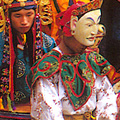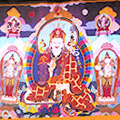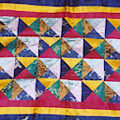Religious Embroidery consists of appliqué work on huge banners and dance costumes at – tshechus, ornamnents and decorations for the altar, profusely embroidered garments for sculptures and other objects used in rituals such as Cushion for the bell (Dril-Dhen), Umbrella (Dhug), Victory Banner (Gyeltshen), Flag (Badhen).
Traditional knee length boots or Tsholham are made of cloth with leather soles and embroidered – colours and decorations depending upon the rank of the civil servant.
Practitioners: Tailoring is done by both men and women, whereas the appliqué and embroidery are done by the men.
Materials: Embroidery is done on silks, brocades, woollen and plain cloth. The thread used is usually made of silk and the subject depending on the purpose could consist of flower decorations, the dragon, the eight lucky signs or huge religious embroidered and appliqué representations of the religious deities.
TRADITION
Religious festivals or tshechus are perfect occasions to glimpse Bhutanese culture – people bring out their finest clothes, their most beautiful jewellery and while the focus of these occasions is prayer – on view are the most spectacular costumes in the most striking colours and the most stunning appliqué thangkhas.
Tshechus, are celebrated to honour Guru Padmasambhava also known as Guru Rimpoche, the precious teacher. They are staged at different places at different time of the year, at temples, dzongs and monasteries throughout Bhutan and are an occasion for reverence and blessing, feasting and socializing.
Tshechus are celebrated for several days (three to five), according to their location. The central focus of these festivals is prayer and religious dances. Performed by monks and laymen, the repertory of the dances is practically the same everywhere.

Religious Dances & Music
The lamas establish the tradition of the dances and the lay people and the monks perform them. It is believed that by attending it one gains merit. Religious dances performed during festivals can be grouped into three broad categories:
- Instructive or Didactic dances with a moral
Examples of this are the dance of the princesses, the dances of the stag and hunting dog, the dance of the judgement of the dead). - dances that purify and protect a place from demonic spirits
Examples of this are the dance of the black hats composed by Shabdrung Ngawang Namgayel, the dance of the masters of cremation ground, the dance of the stage, the dance of the fearsome deities, the dance of the ging with swords. - dances that proclaim the victory of Buddhism and the glory of Guru Rimpoche.
Costumes
Dancers wear spectacular costumes made of yellow silk or rich brocade, often decorated with ornaments of carved bone. Specially striking are the ornate hats and the extraordinary masks.
Masks: The masks may represent animals, fearsome deities, skulls, and manifestations of Guru Rimpoche. These masks are so heavy that dancers protect themselves from injury by binding their heads with strip of cloth to support the mask and they see out from the opening of the mouth.
Atsaras are clowns, with their expressive masks and postures, are an indispensable element in any religious festival. They confront the monks, toss out salacious jokes, and distract the crowd with their antics when the religious dances begin to grow tedious. Believed to represent Acharyas (religious masters of India) they are entitled to mock both spiritual and temporal subjects, and through their distractions infuse a lighter side to otherwise serious matters.

Thongdroel
Tshechus may end with the bestowing of powerful blessings, delivered orally by a High lama or visually with the unfurling of a huge appliqué thangkha called Thongdroel, representing Guru Rimpoche and his Eight Manifestations. The Thongdroel is unveiled at first light to bring enlightenment to all who view it. The faithful believe that by simply viewing a Thongdroel, they can be delivered from the cycle of reincarnations.
The proportions of the figures, the folds in the dress, the mudra or hand gestures, are all depicted in strict accordance with tradition. Some are so huge that they cover a four storey wall.
Sacred silk thangkha (applique) 27 by 30 metres is unfurled once a year for just several hours on the fifth and final day of the Paro festival. The thongdroel depicts Guru Padmasambhava, the founder of Buddhism in Bhutan.
The monasteries also make most beautiful needle-work pictures of the saints on hanging banners. Innumerable pieces of coloured silks and brocades are applied in a most artistic manner with elaborate stitches of all kinds.
The Bhutanese also use a lot of silk or brocade in different colours for decorative purposes, cutting them into thin strips and hanging them in symmetrical undulating patterns (chenzi).

Stitching a Thangkha
The painting on completion is mounted in an attractive brocade frame – only a few tailors are specialised enough to know how to stitch Thangkhas. Every thangkha will have a sherimasi – these are the yellow and red borders around the thangkha. The whole piece is then surrounded by a broader piece of brocade, care being taken to see that the bottom portion is wider than the top and the sides are narrower still. The colour of the brocade will depend on the colour of the thangkha. At the bottom, another rectangular piece of bright silk or brocade is sewn on and this is known as the “door” of the thangkha to reach the central deity. A thangkha will also have a shekhep is a piece of cloth to cover the thangkha – it is traditionally in two colours yellow and red.
The choice of silk cloth will be of the highest quality possible and sewn with accurate straight stitches following the rules of proportion. The corners of the brocades must have a perfect angle and the painting must hang straight.

Religious Embroidery consists of applique work on huge banners and dance costumes at tshechus, decorations for the altar, sculptures, wearing profusely embroidered garments and glittering ornaments.Cushion for the bell (Dril-Dhen)
It can be made from different textiles; brocade, silk, as well as handwoven material. Cushions have different colours and designs and sizes. The Bell and the thunderbolt are placed on this cushion during rituals.Umbrella (Dhug)
Symbolises the authority of the Buddha’s teachings. Just as the umbrella offers protection from the sun, the Dharma also protects people’s spirits from evil.Victory Banner (Gyeltshen)
A symbol of victory over evil, the enemy, it also shows that the doctrine of Lord Buddha still holds sway within the country. It is hung in front of altars, at the top of prayer flags or as a pinnacle on monasteries and palaces.Flag (Badhen)
A symbol of victory over evil.Temple ornament (Chenzig-Dharchang)
Used as decoration.
Palanquin (Ladrey)
It is a type of ornamental offering hung above the altar from ceiling.

Shoes / Boots (Tsholham)
Traditional knee length boots, made of embroidered cloth with leather soles, once commonly worn are now worn only on ceremonial occasions. They are traditionally hand-stitched using sheep and cow hides and decorated with brocades or wool and held in place under the knee with a narrow strap. The shoe colours and decorations depend upon the rank of the civil servant. The main colours used are red and yellow. Both men and women in the country wear them. Today, they are made in Paro and Thimphu.
Applique thangkhas – thongdroel
There are very large thangkhas of more than a hundred feet long, which are used only during religious festivals. The technique in making them is called ‘applique’ and they are usually made with a single deity. Some tshechus end with the displaying of a Thongdroel. The Thongdroel is unveiled at first light to bring enlightenment to all who view it. The faithful believe that by simply viewing this Thongdroel, they can be delivered from the cycle of reincarnations.
Gallery
YOUR VIEWS
PRACTITIONERS: INDIA
Access 70,000+ practitioners in 2500+ crafts across India.
BIBLIOGRAPHY
10,000+ listings on arts, crafts, design, heritage, culture etc.
GLOSSARY
Rich and often unfamiliar vocabulary of crafts and textiles.
SHOP at India InCH
Needs to be written.





